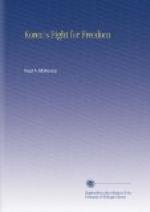Meanwhile China, Korea’s usually apathetic suzerain power, took action. Li Hung-chang sent 4,000 troops to Seoul to maintain order. The Regent, now humble and conciliatory, attempted to put blame for the outbreak on others. But that did not save him. The Chinese, with elaborate courtesy, invited him to a banquet and to inspect their ships. There was one ship, in particular, to which they called his honourable attention. They begged him to go aboard and note the wonders of the apartments below. The Regent went. Once below, he found the door shut, and could hear the ropes being thrown off as the ship hastily departed. It was in vain for him to call for his attendants and warriors waiting on the shore.
They took him to China, and Li Hung-chang sent him into imprisonment and exile for three years, until it was deemed safe to allow him to return.
II
JAPAN MAKES A FALSE MOVE
For hundreds of years it was the ambition of Japan to replace China as the Protector of Korea. It was the more mortifying, therefore, that the Hanabusa incident served to strengthen China’s authority. It gave Peking an excuse to despatch and maintain a considerable force at Seoul, for the first time for hundreds of years.
The Japanese tried to turn the affair to their advantage by demanding-still more concessions. The Korean rulers found it hard to refuse these determined little men. So they adopted a policy of procrastination, arguing endlessly. Now Japan was in a hurry, and could not wait.
The Japanese Minister at Seoul at this time was Takezoi, timid and hesitating constitutionally, but, like many timid folk, acting at times with great rashness. Under him was a subordinate of stronger and rougher type, Shumamura, Secretary to the Legation. Shumamura kept in touch with a group of Cabinet Ministers who had been to Japan and regarded Japan as their model. They mourned together over the growth of Chinese power, and agreed that it was threatening the independence of the country. They repeated the rumour that a secret treaty had actually been signed by the King, recognizing Chinese supremacy in more binding form than ever before. They felt that the Queen was against them. Her nephew, Min Yung-ik, had been on their side when he returned from America. Now, under her influence, he had taken the other side.
Kim Ok-kiun, leader of the malcontents, was an ambitious and restless politician, eager to have the control of money. One of his chief supporters was Pak Yung-hyo, relative of the King, twenty-three years old, and a sincere reformer. Hong Yung-sik, keen on foreign ways, was a third. He was hungry for power. He was the new Postmaster General, and a building now being erected in Seoul for a new post-office was to mark the entry of Korea into the world’s postal service. So Kwang-pom, another Minister, was working with them.




